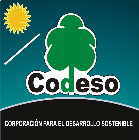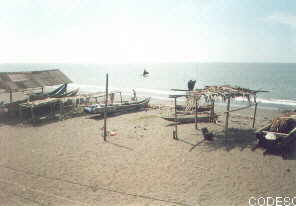CI
Solar electrification project
photovoltaic of the Cauchal community
The Cauchal community is located in the Cayapas Mataje Mangrove Ecological Reserve between San Lorenzo on the coast of Ecuador and Tumaco in Colombia.
The black population of Cauchal lives mainly from the capture and commercialization of shell and artisanal fishing. The average monthly gross income of a family is less than US$30, much of which is spent on transportation.
The solar power system initially consists of 58 Isofoton I 110 panels with a total of 6,380 Wp (peak watts) producing an average of 22,330 watt hours per day. In addition, there are 48 MAC 12 V (volt) 150 Ah (ampere hour) stationary accumulators, 8 Isofoton I 30 A regulators and 2 APS 3600 W Triplite Inverters (alternating current generation of 110 V for the local electrical network).
The Cauchal system is hybrid, that is, it has two sources of energy generation: photovoltaic, which generates around 80% of the daily energy, and a diesel motor-generator, which generates the amount of energy that is missing (with maintenance and fuel costs). ). The commune opted for a hybrid system, because it needs freezers for its commercialization of seafood and the solar system, with limited financing, could not cover the necessary energy.
The shell is harvested by the women and children of the community within the mangrove protected area. It is important that the community has its photovoltaic energy system to be able to carry out daily tasks such as educating children at night, having access to information on radio and television.
The solar system helps preserve the mangrove ecosystem.
Water pumps with solar photovoltaic energy, they do not need transformers, poles. Installation without connection to the public electricity network. Profitable with low daily costs, Irrigation systems, for livestock, with a long useful life.
Electric solar systems independent or autonomous. Support and protection of medical and computer equipment, radio communication, electric fences. Photovoltaic panels, MPPT regulators, stationary batteries (lithium), and pure sine wave inverters.
The system was co-executed by the Cauchal community, CODESO and FEDARPOM S.L., the Federation of Afro-Ecuadorian Artisans Collectors of Mangrove Products based in San Lorenzo, Esmeraldas, Ecuador, Telefax 593-6-780533, fedarpom@ecuabox.com.
The main financing provided the Project for the Development of the Indigenous and Black Peoples of Ecuador PRODEPINE RCN Telefax 593-6-727937, prodrcn@yahoo.com. There was also support from the Illustrious Municipality of San Lorenzo.
The increase in the system was planned to be able to connect a communal freezer, but families with low incomes do not have the possibility of carrying out this task.
Currently the Cauchal community is questioning the water system, which is important for families.
In case you want to support this and/or other communities, contact us by email.
During the day, work is carried out solely with the solar system and at night, in the event that the energy in the accumulators has run out, work is carried out for a short time with the conventional generator, which feeds directly into the local grid and at the same time into the bank. of accumulators, recharging it. When the batteries are full again, the engine is switched off and the system continues to run on the batteries.
The 80 families have during the day the possibility of listening to the radio and using blenders and fans. At night they can use their low energy consumption lamps and their televisions until approximately 10 pm. The freezers are still powered 24 hours.




